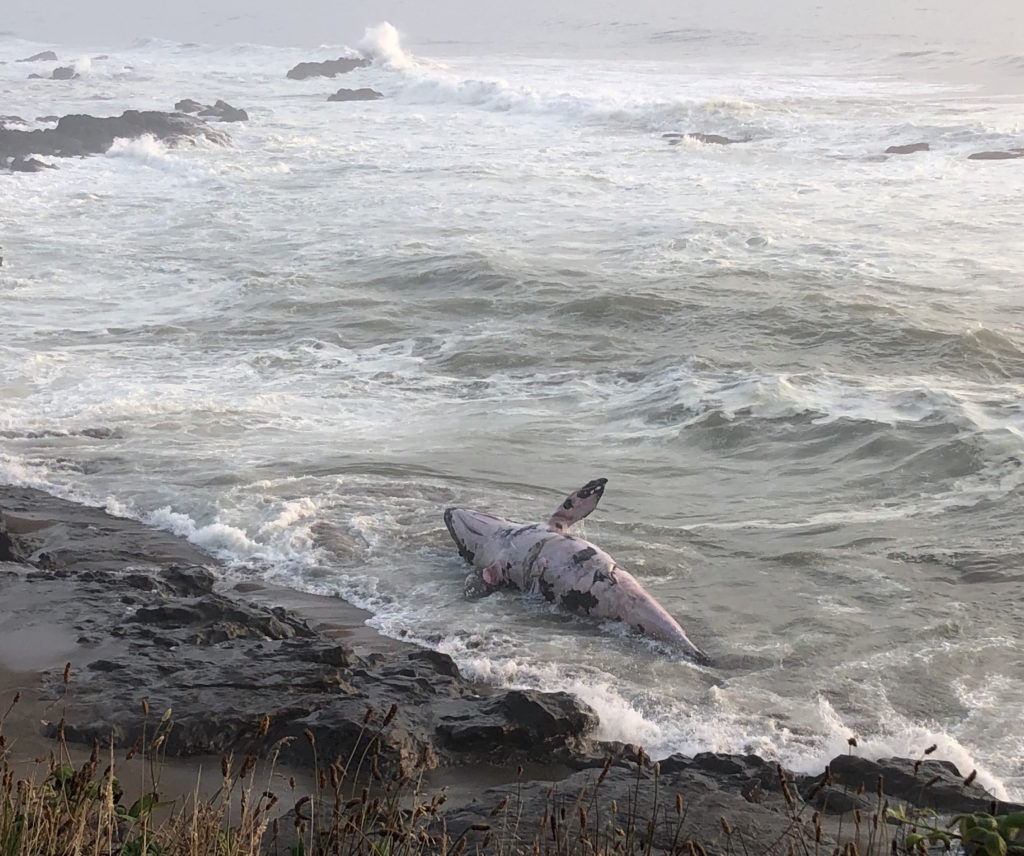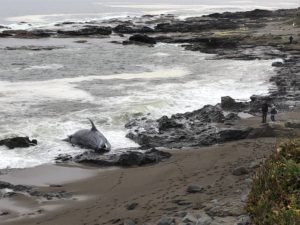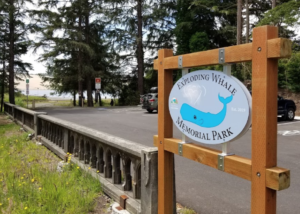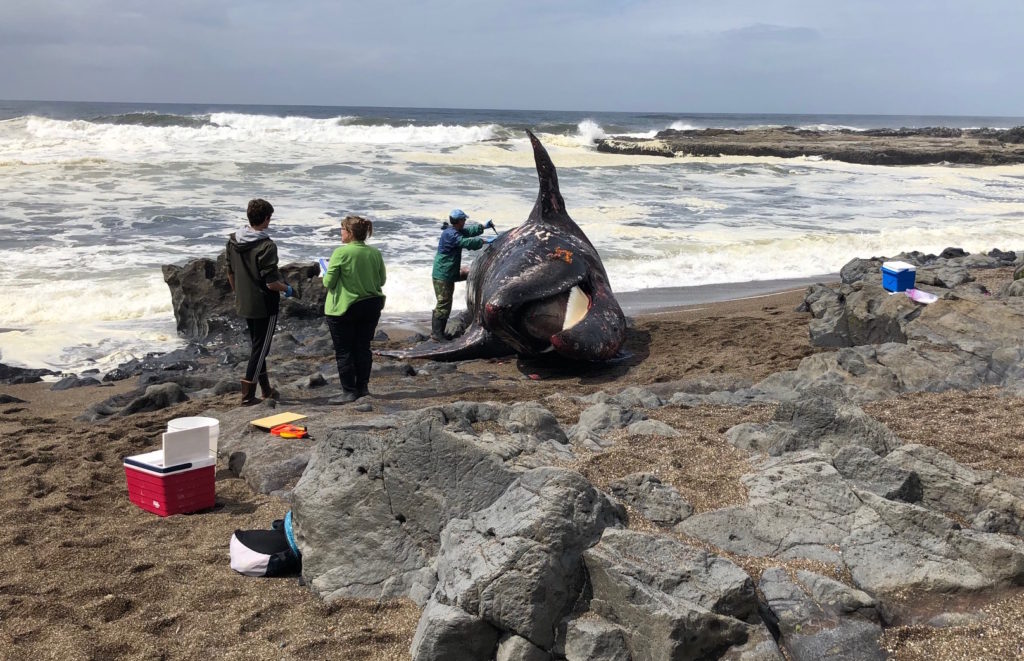
By DANA TIMS and QUINTON SMITH/YachatsNews.com
The rapidly deteriorating carcass of a juvenile gray whale that washed ashore this week in Yachats moved out of a rocky cove below Ocean View Drive overnight Sunday, floated into the Yachats River bay at low tide — and then was washed out to sea during high tide Sunday afternoon.
The carcass began breaking up Saturday night and Sunday, scattering parts of the 30-foot body along the Yachats shoreline.
The 30-foot young male washed ashore Monday, likely hunted and drowned by orcas. It came into a rocky and protected cove below Ocean View Drive between West Sixth and Seventh streets — and until overnight Sunday tides were not able to take the floating carcass back out to sea.

Normally, the state would opt to bury a washed-up carcass. But that wasn’t an option in this case both because of the lack of access to the whale and the rocky, largely sandless area where it came ashore.
“The current plan is to leave it in place and let nature take its course,” said Chris Havel, spokesman for the Oregon Parks and Recreation Department. “We know this can be a smelly and unpleasant experience in the short run, but there aren’t any practical alternatives with it in this location.”
Since Tuesday, the outer layer of the whale’s dark skin has been rubbed off, leaving a white and pink behemoth rolling around in the surf and occasionally floating in the cove. It began breaking up during the weekend and floated out of the cove overnight.
No exploding whales now
Regardless of where a whale carcass washes up, however, the jurisdiction faced with disposing of it faces problems as gargantuan as the whale itself.

Oregon state officials learned that lesson the hard way in 1970, when a dead and decaying, 8-ton sperm whale washed up on a beach in Florence. Worried that beachcombers might climb onto – and fall into – the rotting carcass, the Oregon Highway Division decided to reduce the whale to smaller, more manageable pieces by blowing it up.
A large crowd of spectators gathered to watch the detonation. The resulting explosion sent a 100-foot-high column of blubber and sand skyward, and almost immediately giant chunks of whale began raining down on screaming, scurrying spectators. One piece was so big that it crushed a car parked far from the blast site.
Needless to say, explosives have been permanently removed from the state’s whale-disposal tool box.
The experience lives on, however, at “Exploding Whale Memorial Park,” a small interpretive area near the blast that Florence residents created last year to commemorate the incident.
Officials in Southern California faced a similar dilemma several years ago, when the 43-foot carcass of a gray whale washed ashore on a small stretch of beach in San Clemente regarded as the state’s most popular spot for surfers.
Strong ocean currents and high winds ruled out towing the carcass back into the ocean, since in all likelihood it would just wash back in. Similarly, the beach’s compact size eliminated the option of burying the animal.
Given the lack of choices, officials cut the whale into what they called “appropriate, efficient” pieces and hauled them to a landfill for disposal.
Two years ago, in Washington, officials managed to tow the corpse of a 40-foot whale a short distance from where it washed up near Port Hadlock to a privately owned stretch of beach nearby.
Stefanie Worwag, one of the property’s owners and a veterinarian, promptly cut the whale open in a bit of backyard research.

NOAA investigates strandings
Overall, the number of gray whale strandings – as opposed to the apparent orca-related attack on Yachats’ whale – are down so far this year, when compared to both 2019 and 2020, according to the National Oceanic and Atmospheric Administration.
Some 43 gray whales have been stranded so far this year across Alaska, Washington, Oregon and California. That compares with 79 in 2020 and 122 in 2019.
However, a spike in strandings starting in 2019 – as compared with numbers going back to the early 2000s – prompted NOAA officials to declare an “unusual mortality event.”

“We are keeping track of these strandings pretty carefully,” said Michael Milstein, public affairs officer for NOAA’s West Coast operations. “There is limited information we can get in terms of biology and we want to learn as much as we can about each event, including the one in Yachats.”
Jim Rice, head of the stranding network, took samples of the Yachats whale on Tuesday so that scientists could try to determine what kind of condition it was in and possibly how it died. But he said marks on the head and back of the young whale likely meant that a pod of orcas attacked and drowned it.
Scientists, in trying to evaluate the spike, began noticing that whales returning from their winter feeding grounds in the Arctic back to calving lagoons off Mexico were showing up emaciated.
Some speculated that burgeoning overall whale populations were consuming enough ocean nutrients to leave other whales with an insufficient food supply.
“A sizable number of those got stranded,” Milstein said. “Still, in total numbers, we are seeing more whales than at any time over the last decade.”
The population now numbers well over 20,000 gray whales, he said, far higher than the dwindling numbers in the late 1960s, when fewer than 14,000 grays were counted.
Still, the sight of a single decomposing whale carcass bobbing in the waters off Yachats is a startling, albeit rare, sight.
State officials say they’d prefer to have options other than leaving it in place, but their choices of doing anything proactive are roughly zero.
“We can sometimes forget that the coast is mostly a natural, wild place,” the state’s Havel said, “and that for every thousand sunsets, we also get a front row seat to the cycle of life and deaths always taking place on the ocean shore.”
- Dana Tims is an Oregon freelance writer who contributes regularly to YachatsNews.com. He can be reached at DanaTims24@gmail.com



